Introduction
If we’re being honest with each other, when most people think of Iceland, they picture waterfalls, puffins, and Game of Thrones locations (with the odd person quoting a line in a poor Yorkshire accent from the show). But lurking beneath all that postcard perfection? Fire. Lava. Earth-shaking drama – and, no, I’m not talking about Eurovision.
That’s right. Iceland isn’t just the land of ice and trolls. It’s also sitting smack on top of one of the most volcanically active spots on the planet, directly between two of the world’s major faultlines (North American plate, and the Eurasian plate).
If you’re planning a campervan road trip across Iceland and wondering how close you might get to molten lava (without melting your tyres), this guide is for you. We’re diving into how many active volcanoes Iceland really has, which ones are worth watching, and what to expect when the ground decides to test if your legs still work like they used to before (guess the artist to that lyric and I’ll unveil it at the end).
Why Iceland Is a Volcanic Hotspot
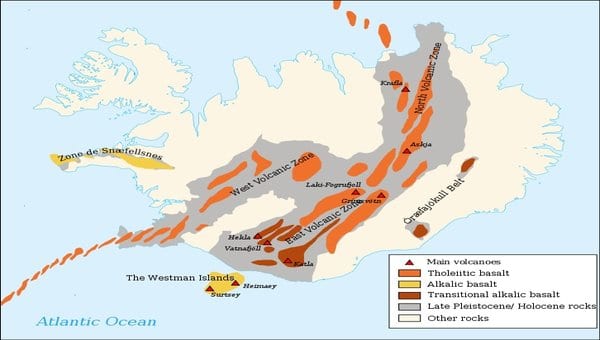
Iceland exists because of volcanoes. Full stop. The island was born from fire and continues to grow (or occasionally explode) because of it. In fact, Iceland is one of the youngest landmasses in the world and continues to grow measurably each and every year (about 5cm) irrespective of it a ridiculously to pronounce volcano goes off or not.
Sitting directly on the Mid-Atlantic Ridge, Iceland is the child of two tectonic plates drifting apart. As the North American and Eurasian plates separate, magma rises to fill the gap. Add in a powerful hotspot below the surface, and you’ve got the geological equivalent of a pressure cooker with a dodgy lid.
Volcanic activity here is not a fluke. It’s the main event. Lava flows have shaped the landscape, fed myths, rewritten flight schedules (more on that later), and have even been considered a direct impact for the French Revolution (Laki Eruptions 1783 – 1784). From bubbling geothermal areas to freshly formed lava fields, Iceland wears its fiery heart proudly.
What Does “Active Volcano” Really Mean?
The term “active volcano” might sound dramatic, but it doesn’t mean lava is shooting out of the ground every Tuesday.
In geological terms, a volcano is considered active if it has erupted in the past 10,000 years. Which is a blink of an eye in volcano years, and not something you can set your watch to as a human going from cavemen to Teslas.
Some volcanoes erupt every few years. Others simmer quietly for centuries, then suddenly wake up in a bad mood. Iceland has around 130 volcanic mountains, and roughly 30 of those are considered active by this definition.
So no, the ground is not always rumbling (or at least that you would always feel it). But yes, Iceland’s volcanoes are very much alive. And when they do erupt, they often put on one heck of a show.
Quick Facts About Iceland’s Volcanoes
Iceland sees an eruption on average every four to five years. Sometimes it’s a small one. Sometimes it’s a “shut-down-European-airspace” kind of situation.
The country is home to one of the largest lava flows on Earth in recorded history: the Laki eruption of 1783. Spoiler alert: it didn’t go well for Europe, particularly if you happened to be an 18th century member tof the French monarchy.
Most volcanoes in Iceland are covered by glaciers. When they erupt, the result is a jökulhlaup (glacial flood) which is a regular occurrence in Icelandic summers as the temperatures rise whether an eruption occurs or not. However, what might not be so obvious is that these types of subglacial volcanoes can be very explosive.
Despite this drama, Iceland has world-class monitoring and warning systems. You’re more likely to be inconvenienced than endangered. After all, it’s a country now with regular eruptions on the Reykjanes peninsula and there have been no fatalities at the time of writing.
Most Active Volcanoes in Iceland Today
1. Sundhnúkagígar Crater Row
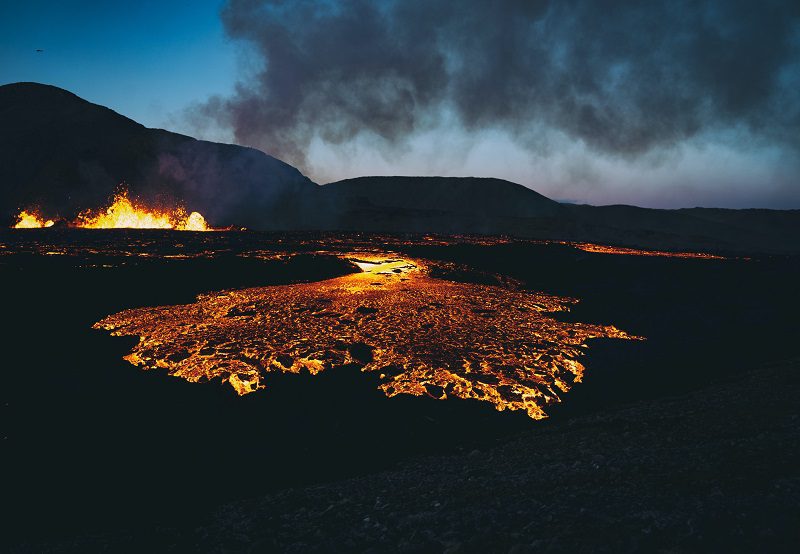
This crater row near Grindavík and the Blue Lagoon has been grabbing headlines for all the wrong reasons lately.
Sundhnúkagígar erupted multiple times in 2023 and 2024, sending lava across roads, threatening power plants, and making the entire Reykjanes Peninsula feel like it was sitting on a giant stovetop.
It is part of a wider system known as Svartsengi, and eruptions here have come fast and frequent – sometimes with as little as a few days or hours warning. If you’re travelling in this region, keep an eye on SafeTravel.is for real-time updates.
Currently, there are strict regulations and processes in place to ensure everyone is safe, such as evacuation procedures at major tourist destinations like the Blue Lagoon.
2. Fagradalsfjall (Reykjanes Peninsula)
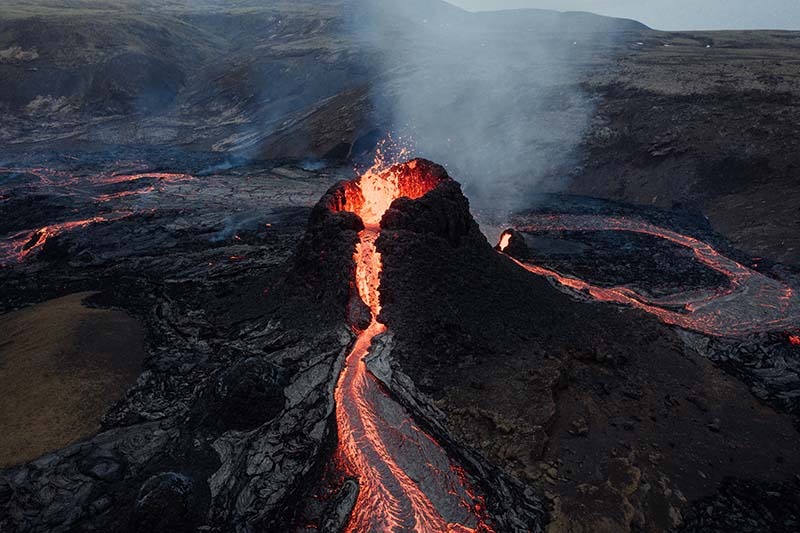
This was the superstar of 2021. After 800 years of silence, Fagradalsfjall erupted and suddenly everyone and their drone was hiking across a lava field.
It was a surreal time living in Iceland. It was a regular conversation at meal times as to whether you wanted to go and check out the eruption at night or stay in and watch a Netflix movie. I must admit the worst part was paying for parking in what I can only describe as poorly maintained plateau of rock (but I’m British, paying for parking anywhere is my kryptonite).
Unlike the more explosive volcanoes, Fagradalsfjall is a relatively friendly kind of fiery. Its eruptions have mostly been slow-moving lava flows, creating brand-new land and TikTok content by the minute.
It’s relatively accessible from Reykjavík, and campervan travellers have often in the past added a stop at the Reykjanes lava fields to see where the Earth opened up.
However, it is not advisable to explore this route at the present time of writing due to the instability of the region – always follow local guidance and ask our team if you’re unsure of where you can and can’t go.
Other Major Active Volcanoes to Know
3. Eyjafjallajökull
Say it with us: EY-ya-fyat-la-yo-kutl. Or, as my Icelandic teacher partner explains, when in doubt just try saying “Eh! Ah! fat little yogurt!” really quickly.
Yes, it’s the one that shut down European air traffic in 2010 and turned travel plans into ash-laced chaos. And yes, its name is still mispronounced with confidence by every news anchor who dares to try.
Eyjafjallajökull erupted through the thick ice of its glacier covering, creating a powerful explosive reaction that sent fine ash high into the stratosphere. This ash cloud drifted across Europe, grounding over 100,000 flights and leaving millions of passengers stranded, proving that even tiny volcanic particles can cause big global disruptions.
Though currently quiet, Eyjafjallajökull remains under close observation. Its eruptions have historically been linked to increased activity in nearby Katla, its larger and more volatile neighbour lurking beneath the Mýrdalsjökull glacier (we’re coming onto this in a sec).
Scientists believe these two volcanoes may be connected deep underground, which is why Eyjafjallajökull’s behaviour is often seen as more than just a solo act, it could be the warm-up act for something bigger.
4. Bárðarbunga
Hidden beneath the thick ice of Vatnajökull glacier, Bárðarbunga is one of Iceland’s largest and most powerful volcanic systems.
In 2014, it made headlines when it erupted continuously for six months, pumping out more than 1.5 cubic kilometres of lava (0.9 cubic miles). This eruption formed the Holuhraun lava field, the largest lava flow in Iceland since the 18th century.
While the eruption itself wasn’t explosive, the scale of the event was staggering. Bárðarbunga’s caldera even subsided by over 60 metres due to the sheer volume of magma released.
Although things have been relatively quiet since then, Bárðarbunga is still very much alive. It remains closely monitored by the Icelandic Met Office due to its complex magma plumbing system and potential for future activity.
If your campervan trip takes you anywhere near the Highlands or Vatnajökull National Park which you’ll clearly see along the South Coast, this sleeping giant is a reminder of just how much power lurks beneath the surface.
But, don’t worry too much. Even if you are in the vicinity of Bárðarbunga, without a plane or helicopter ride you won’t be able to get anywhere near it’s toasty rages, if there are any.
5. Katla
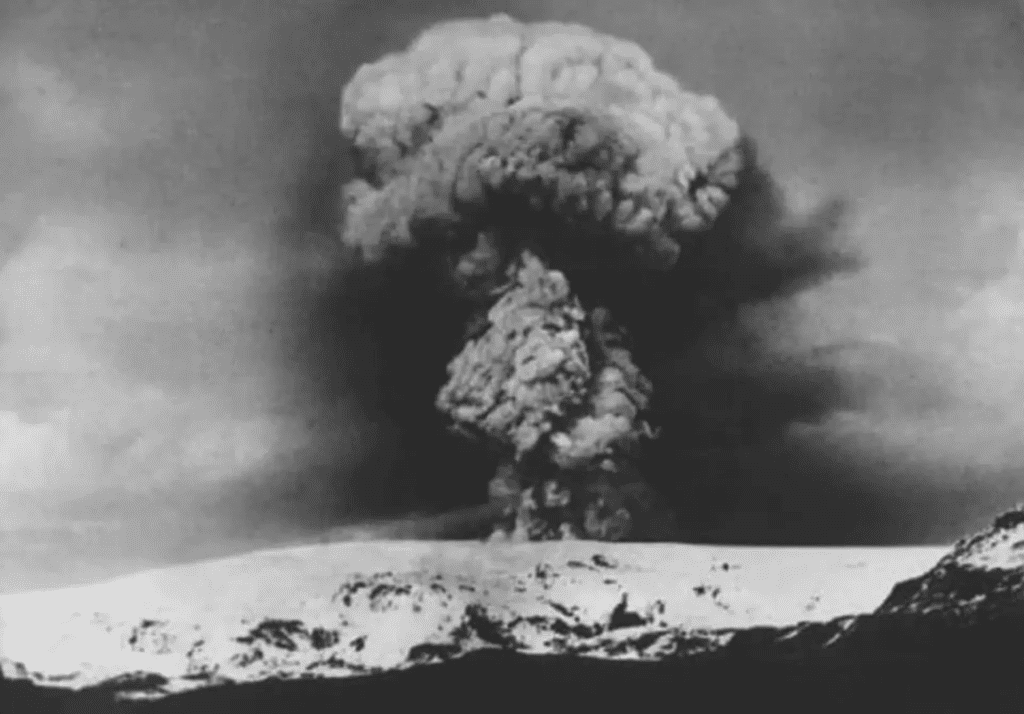
Katla is the volcano that always seems to be lurking in the back of Iceland’s collective mind.
Hidden beneath the ice cap of Mýrdalsjökull glacier, Katla is considered one of the most powerful and overdue volcanoes in the country. Historically, it erupts roughly every 40 to 80 years. The last major eruption was in 1918, and if you are doing the maths, yes, we’re well into borrowed time, with any earthquake stirs above 3 on the Richters Scale regularly being reported in the local news.
What makes Katla particularly worrying is its location beneath a thick glacier. Any future eruption would likely trigger massive glacial floods (jökulhlaups), causing rapid downstream flooding and serious infrastructure challenges, particularly for the town of Vík close by, and a keen tourist destination.
Despite its ominous reputation, Katla has been fairly quiet in recent decades, although it occasionally rumbles with small seismic swarms and geothermal activity. These are closely monitored by the Icelandic Met Office, making Katla one of the most watched volcanoes in the country,and for good reason. When she goes, she doesn’t hold back.
For those of you fancying a little extra adrenaline now you’re aware of Katla’s might, you can take a snowmobile tour throughout the year which does traverse across a large section of Katla’s caldera. Just saying!
6. Hekla

Nicknamed the “Gateway to Hell” by medieval Europeans, Hekla has erupted more than 20 times since the year 874, earning its reputation as one of Iceland’s most unpredictable volcanoes.
It stands tall and elegant with a symmetrical cone shape, often cloaked in snow, making it look more like a mountain from a fairy tale than a threat from below.
But that beauty is deceiving. Hekla is known for giving little to no warning before erupting. In fact, some of its past eruptions began with just a 30-minute heads-up.
Because of its volatile nature, scientists keep a very close eye on Hekla’s seismic behaviour, monitoring everything from ground deformation to gas emissions.
While some hikers have climbed it in the past, local authorities now strongly discourage it unless the volcano has been especially quiet for a long time. Even then, access is taken seriously because Hekla is not the type of volcano you want to second-guess.
Fun fact for you: Both Hekla and Katla are common girls names in Iceland…I assume this is not due to their fiery nature!
7. Grímsvötn
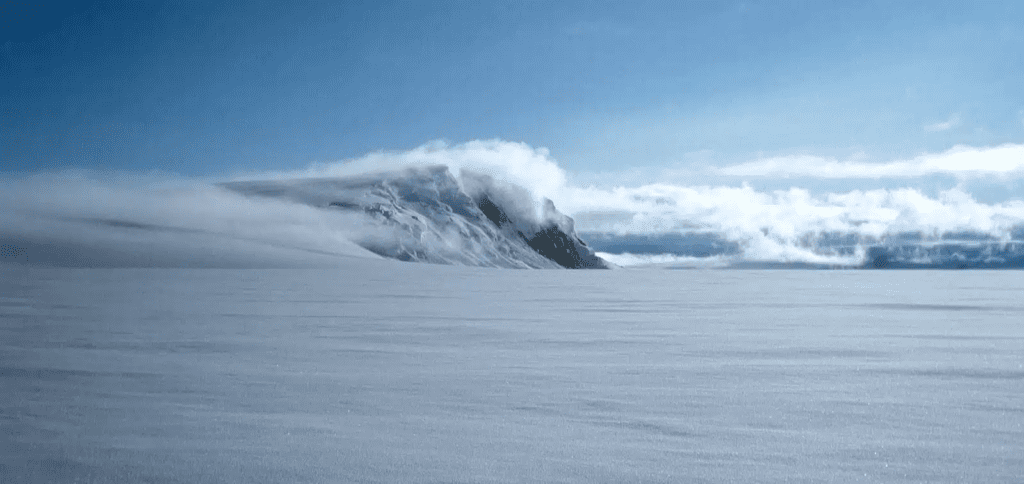 Photo Credit: Roger McLassus via Wikimedia C.C.
Photo Credit: Roger McLassus via Wikimedia C.C.
This one has a short fuse.
Grímsvötn is another glacier-covered volcano and one of Iceland’s most active and explosive. Nestled under the Vatnajökull ice cap, this volcano erupts more frequently than most others in Iceland. It last erupted in 2011, sending plumes of ash kilometres into the sky and prompting widespread airspace closures.
Scientists believe Grímsvötn operates on a semi-regular cycle, with major eruptions every decade or so. Because of this, it is constantly monitored for seismic tremors, gas emissions, and ground deformation. The presence of a subglacial lake under its surface adds complexity, as melting ice can rapidly generate dangerous pressure build-ups.
When Grímsvötn does erupt, like the other major sub-glacial volcanoes it often triggers jökulhlaups whose dramatic glacial floods can transform tranquil valleys into violent torrents. These floods can destroy roads and bridges in their path and are a key reason why Grímsvötn is treated with such caution.
If you’re planning on travelling around the South Coast of Iceland – in the opens plains near Vatnajökull National Park, there is a stop which shows a battered bridge that was previously washed away into it’s current position by a jökulhlaup. When you see how far away the glacier is in the North when stopping by this ‘bridge’ you can really feel the power of the nature around you (hopefully without experiencing an eruption!)
Despite its volatility, it remains a fascinating destination for those travelling through the Vatnajökull region. Just keep one eye on the updates from the Icelandic Met Office, and maybe keep the other on your campervan’s escape route, or just bring Nicholas Cage with you – whatever works.
Other Active Volcanoes in Iceland to Watch
Askja: A Sleeping Giant with a Volatile Past

Located deep in the Icelandic Highlands, Askja is not your average volcano. Its most infamous eruption in 1875 was so powerful that it scattered ash across parts of Scandinavia and disrupted life across East Iceland, forcing entire communities to abandon their homes.
Today, what remains is a dramatic, otherworldly landscape featuring a sunken caldera partially filled by the vivid blue waters of Lake Öskjuvatn.
Askja is remote and wild, requiring a 4×4 adventure across lava fields, river crossings, and desolate terrain that feels more like Mars than Earth. It is this alien vibe that also made it the training ground for Apollo astronauts in the 1960s, who prepared here for their missions to the Moon.
Despite its sleepy appearance, Askja remains an active system, and occasional seismic activity keeps scientists on their toes (some ground rising was reported as recent as 2023). If you are up for the challenge, this is one of the most incredible volcano stops in Iceland – completely off-grid, unforgettable, and just a little bit lunar. And, how often can you say you bathed in the blue waters of an active volcano caldera?
Öræfajökull: Iceland’s Tallest Volcano
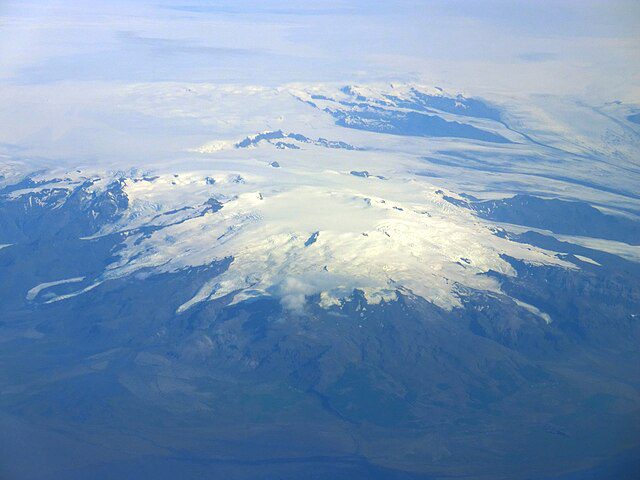 Photo Credit: 24dakenlo via Wikimedia C.C.
Photo Credit: 24dakenlo via Wikimedia C.C.
Towering over the southeast and crowned by the icy slopes of Vatnajökull, Öræfajökull is Iceland’s highest peak and one of its most commanding volcanic presences. It has a reputation for both beauty and brute force.
Its eruption in 1362 remains one of the deadliest in Icelandic history, obliterating entire settlements and sending ash as far as mainland Europe. A second, smaller eruption followed in 1727, though the volcano has been relatively silent since.
That said, silence doesn’t mean slumber. Öræfajökull has shown signs of renewed activity in recent years, including increased seismic movement and the appearance of a small ice-cauldron at the summit, which is often an early signal of magma shifting below. Scientists continue to keep a close eye on it using seismic sensors, satellite imagery, and ground-based instruments.
For travellers exploring the southeast or driving the South Coast route, the mountain looms large and ever watchful. It’s a stunning photo stop, but also a gentle reminder that Iceland’s geology is never truly at rest.
Kverkfjöll: Steam, Ice, and Hidden Power
Another volcano hiding beneath the mighty Vatnajökull glacier, Kverkfjöll is a fascinating mix of opposites. Here, steaming geothermal vents crackle beneath ancient ice caps, and the landscape is a surreal contrast of fire and frost.
While there hasn’t been a recorded eruption in modern times, the area constantly simmers with geothermal activity, including boiling rivers, steam-filled caves, and the occasional ice cauldron that gets volcanologists twitching with curiosity.
It’s one of those places where the Earth feels very much alive, even when it is whispering instead of roaring. If you are campervanning near the northern edge of Vatnajökull, it is a remote but rewarding detour for those keen on seeing Iceland’s hidden forces at work.
Torfajökull: Iceland’s Largest Geothermal Area
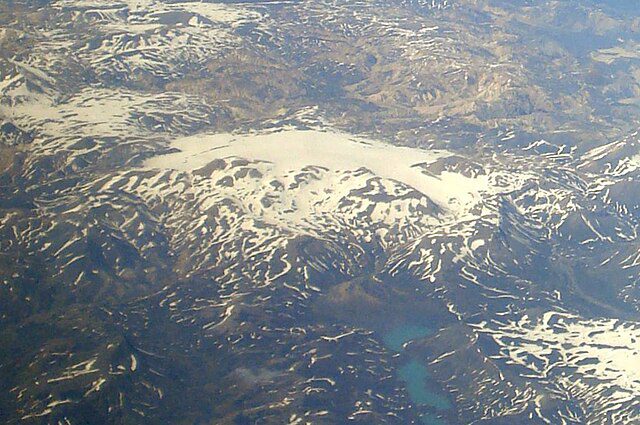 Photo Credit: TommyBee via Wikimedia C.C.
Photo Credit: TommyBee via Wikimedia C.C.
This one is a feast for the senses. It looks like painter’s palette hills splashed with every earthy colour imaginable, with steaming vents that whistle like a kettle about to boil, and the scent of sulphur strong enough to clear your sinuses.
Torfajökull erupted back in the 15th century, but don’t let its long nap fool you. The area remains Iceland’s largest geothermal region, where the land practically breathes beneath your shoes.
It is located just south of the Landmannalaugar hot springs and hiking trails, making it a surreal add-on for those already exploring the Icelandic Highlands. The contrast of fiery geothermal steam rising against patches of snow and rolling lava fields is something out of a dream, or at the very least, a high-budget fantasy film.
Whether you are here for a short walk or a multi-day trek, Torfajökull is a living, steaming reminder that Iceland’s inner fire never truly goes out.
Krýsuvík–Trölladyngja: Geothermal and Unpredictable
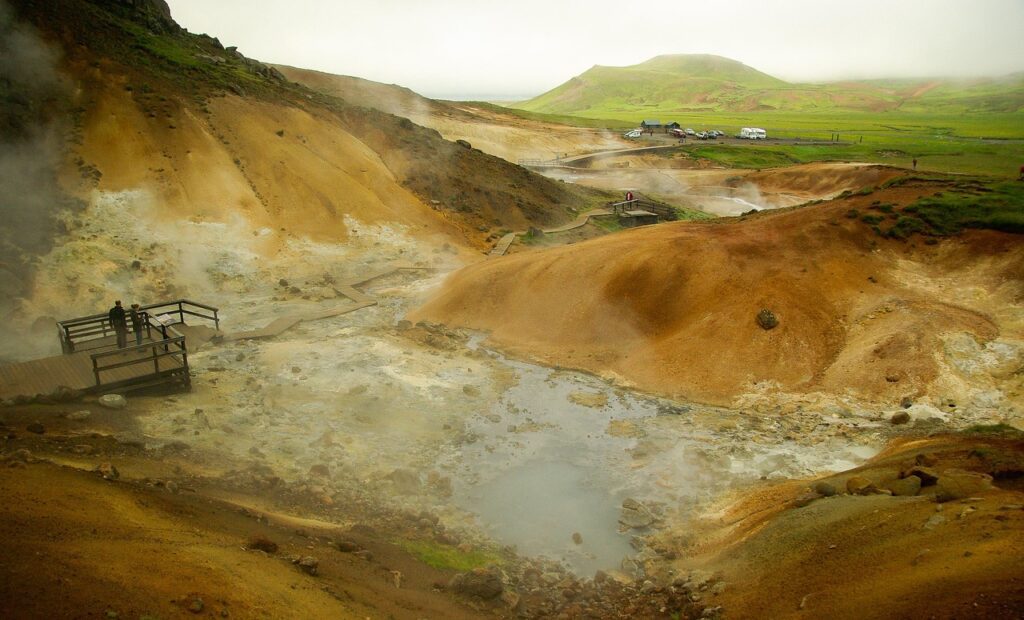
Part of the ever-watchful Reykjanes Peninsula system, the Krýsuvík–Trölladyngja area has been quietly rumbling in the background, registering frequent seismic swarms and noticeable ground uplift in recent years.
While it hasn’t erupted in living memory, experts consider it one of the more unpredictable zones thanks to its proximity to other active volcanic systems like Svartsengi and Fagradalsfjall.
This area is geothermally vibrant, dotted with steaming vents and mud pools that hint at the restless forces below. Scientists monitor it closely due to its history of unrest and the possibility that it could one day join the eruptive club.
Due to the proximity to the currency active volcanic regions, ensure you check safetravel.is for updates prior to journeying there. We’d like our guests (and campers) more rare and less well done.
Hengill: A Volcanic Powerhouse Near Reykjavík
 Photo Credit: Berserkur via Wikimedia C.C.
Photo Credit: Berserkur via Wikimedia C.C.
Technically still active, Hengill is one of Iceland’s largest geothermal areas and plays a crucial role in powering Reykjavík and surrounding towns with sustainable energy. Its volcanic system might not have erupted in the last couple of millennia, but it’s far from asleep.
You can hike through Hengill’s steaming valleys, cross bubbling mud pots, and walk past vents puffing away like a grumpy old troll, or the smoking area of a downtown Reykjavík bar.
Trails crisscross the area, offering panoramic views over Þingvallavatn and even connecting to Reykjadalur’s hot river, where you can enjoy a well-earned soak.
It is one of the few places in the world where you can literally feel the energy of the Earth beneath your boots while soaking in the benefits of it at the same time.
How Iceland Monitors Volcanic Activity
This isn’t a land where eruptions catch people wildly by surprise anymore. The Icelandic Met Office runs a tight ship when it comes to volcanic monitoring.
They use GPS, gas sensors, seismic activity, satellite imagery, and even helicopters to track what’s going on under the surface.
Alerts and updates are shared publicly on Vedur.is, and if anything looks wobbly, they’ll tell you.
For tourists, SafeTravel.is is your best friend. It’s updated in real time and used by locals too. To be safe, always check it before heading into volcano country.
Is It Safe to Travel During an Eruption?

Usually, yes.
If there is an eruption, areas around it are quickly closed, and updates come through fast. The rest of the country keeps running.
In fact, many travellers have visited Iceland during an eruption and said it was one of the highlights of their trip.
Lava flows are usually slow. Ash clouds (if any) are tracked carefully. And the locals? They’ve done this all before. For them, it’s just life as usual with something interesting to talk about at dinner times.
You may get rerouted or miss a specific attraction, but Iceland is good at rolling with these kind of punches. Rest assured that the most recent eruptions pose no threat of ash clouds, but can display an increidble landing and take-off opportunity to see lava burning beneath you. Trust me, that does not get boring!
What Tourists Should Know Before Visiting
Volcanic eruptions in Iceland aren’t like Hollywood disasters. But they still require respect.
Don’t ignore closures or warnings. Don’t walk on fresh lava. Don’t camp too close to an eruption site thinking you’ll get a good sunrise shot.
Respect nature, pack warm gear, check your updates daily, and if you’re not sure whether that weird eggy smell is sulphur or something worse, just ask a local.
And, please always, always, always follow the expert advice which is updated immediately in the threat of any danger (Safe Travel is also in the name…).
Where Can You Learn More About Volcanoes in Iceland?
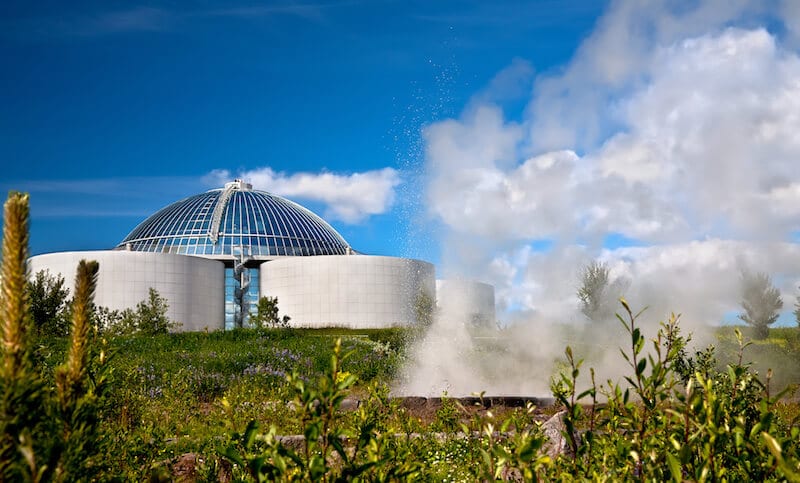
Lava Centre
Located in Hvolsvöllur along Iceland’s South Coast, the Lava Centre is an immersive, interactive museum that’s equal parts science lab and dramatic cinema. It’s built for volcano-curious travellers of all ages, with exhibits covering everything from tectonic plate movement to historic eruptions and current seismic activity.
You’ll get hands-on with earthquake simulators, dynamic lava visuals, and real-time earthquake data from across the country. If you’re heading toward Vík or beyond, this is the perfect warm-up act for the volcanic wonders waiting ahead. Plus, their gift shop has some of the best lava-inspired souvenirs around, because who doesn’t want a fridge magnet shaped like a volcano?
Perlan
This striking glass dome perched above Reykjavík offers far more than just panoramic city views. Inside, you’ll find a multi-sensory volcano experience complete with a simulated eruption, bubbling lava flows, and a journey through Iceland’s explosive geological history.
Perlan also houses a real ice cave, a planetarium with a virtual Northern Lights display, and exhibitions that explain the forces shaping the island. It’s a great blend of science, spectacle, and Instagrammable views under one curved roof (if you’re in the city during Winter time, it’s also a regular part of town to catch a glimpse of the Northern Lights).
Eldheimar
Over on the Westman Islands, Eldheimar is a museum quite literally built on history. It stands where lava from the 1973 Eldfell eruption buried an entire neighbourhood under molten rock.
As you walk through the reconstructed ruins, you’ll see original household items frozen in time and learn what it was like when the residents had to flee in the dead of night.
The exhibitions include a mix of intriguing personal stories with impressive geological displays, making it one of the most moving volcano-related experiences in Iceland. It’s eerie, emotional, and absolutely unforgettable.
You will also have the ability to step outside of the museum, look left and see two very obvious active cone volcanoes. The heat still emits strongly that locals (and Gordon Ramsay…though his was stolen) have baked bread in the rock overnight.
What Do You Need to Know About the Reykjanes and Svartsengi Systems?
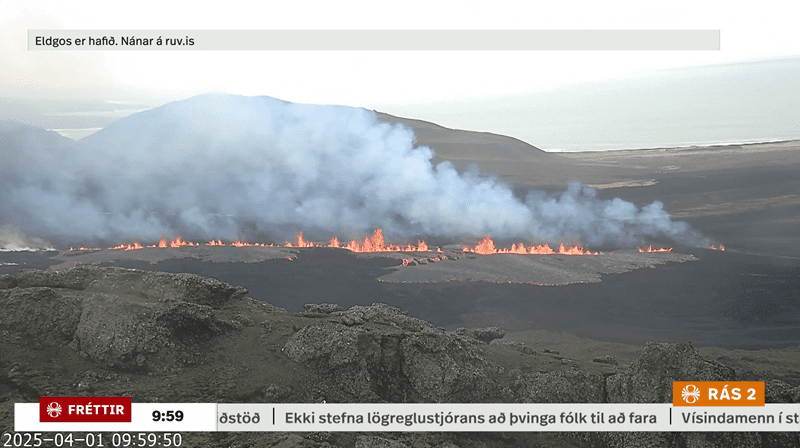 The eruption started around 10am on 1 Apri. It is 11th eruption on Reykjanes Peninsula since 2021.
The eruption started around 10am on 1 Apri. It is 11th eruption on Reykjanes Peninsula since 2021.
This is where all the recent volcanic action has been bubbling.
Reykjanes had been quiet for 800 years until it suddenly wasn’t. Now it is like your friend who got a taste for karaoke and won’t stop.
The Svartsengi system feeds both Sundhnúkagígar and the nearby Blue Lagoon area. It is geothermally rich, tectonically active, and the focus of intense scientific interest right now.
If you are planning on exploring the Reykjanes Peninsula or heading to the airport, keep an eye on updates. It’s still perfectly safe to visit, but things can change quickly.
Conclusion
So, how many active volcanoes are there in Iceland?
The official answer is around 30. But the more accurate answer is: enough to keep life interesting.
With a campervan, you can chase lava fields, hike steaming hills, or camp close enough to landscapes born just months ago.
Just check the alerts, follow the signs, and bring your sense of wonder (and a decent pair of shoes).
Need a ride to the volcanic frontlines? Check out our campervan rentals and hit the road. Lava not included.
ANSWER:
Artist Name: Ed Sheeran (likely now found at a Castle on some Hill).
Back